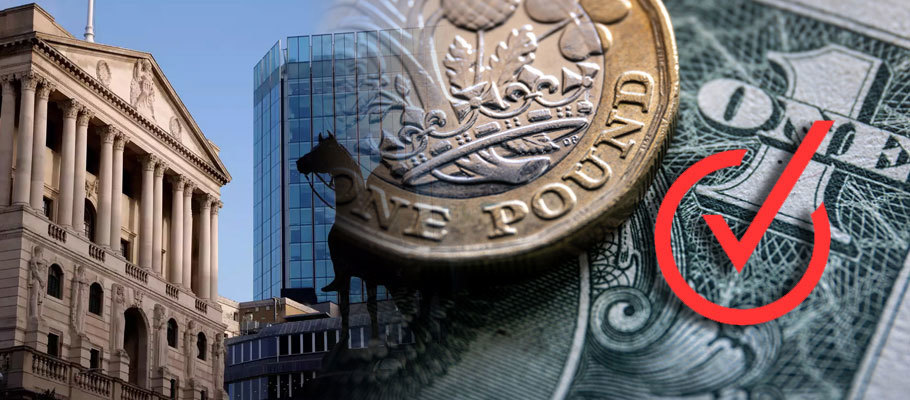
Published: October 12th, 2022
Sterling was steady against the greenback and stronger against the Euro at the start of this week’s session, buoyed by positive news on Britain’s fiscal front, plus the launch of a new facility from the Bank of England to help stabilise domestic money markets.
The Treasury said it would bring a vital fiscal policy update forward to 31st October, along with publication of independent economic forecasts in a bid to reassure investors that Westminster’s economic plans are working.
Arrival of the government’s Medium-Term Fiscal Plan had been scheduled for 23rd November, which threatened to elevate market uncertainty over the outlook for UK finances for an extended period of time. The Treasury said it would also publish a fiscal and economic forecast from the Office for Budget Responsibility (OBR) alongside the Medium-Term Plan.
Barclays senior economist Simone French told Bloomberg that bringing publication of the budget forecasts forward 'does reduce uncertainty over Gilt performance. But securing Cabinet agreement on spending cuts and demonstrating the wisdom of shifting the medium-term fiscal rule to five years make this a bold decision by the Treasury.’
On Tuesday the Pound to Euro exchange rate moved higher by a third of a percent in the hours following the announcement. The Pound to Dollar rate remained unmoved at 1.1044.
The Bank of England said on Monday that it planned to double the size of its daily emergency auction facility from GBP 5BN to BGP 10BN. The facility is used to purchase long-dated government bonds. A new facility has also been launched that gives the banking sector more liquidity for pension funds if they need it in the future.
Barclays’ French said it was sensible for central bankers to expand the size of repo operations and extend its Gilt operations ‘given all uncertainty generated by last week’s roll-off. Threadneedle Street still faces challenges in the coming weeks, with active quantitative tightening scheduled to begin on 31st October’.
French says the message being sent to forex traders is clear: the BoE is closely monitoring markets for signs of stress and will respond when needed. That will hopefully calm skittish investors worried about recent events and lacking confidence in the current, gaffe-prone antics of the Truss government on the economy.
An analyst note from Vanda Research said that the additional measures from the BoE ‘will provide a backstop for UK pension funds and gilt markets with the bank buying more bonds before temporary bond-buying ends to shore up markets. The new facilities also suggest the BoE is ready to do whatever is necessary to sidestep a full-blown Sterling crisis.’
Analysts and major banks have been sounding the alarm on Sterling since early September, when HSBC said Britain’s economy might be ‘hard-wired’ to undermine GBP over the long-term.
The bank said trends in UK output suggest Blighty won’t be able to sustain a currency that can post gains over a multi-year timescale. The only way out of the trap would be to reduce reliance on imports, which exposes GBP to the whims of offshore investors.
Because Britain is a net importer, in economic terms the country spends more than it earns. For HSBC that represents a 'core' problem that could mean bearish prospects for the Pound.
‘Manufacturing and selling more than you buy provides a fundamental strength that is crucial for fiat currencies,’ the report from HSBC’s European FX Unit says. ‘With a strong and stable source of funding, Sterling would be less vulnerable to global headwinds and be on a better footing to make gains.’
‘For both Sterling and the Euro, the picture looks increasingly worrying’.
The bank said the UK and Eurozone are going to be challenged by a cyclical dynamic that wraps together higher inflation, weaker growth, and tightening monetary policy.
‘The more concerning medium-term threat is the deterioration in both currencies’ core balances.’
AUD is an example of a currency that continues to see gains thanks to a strong core. The country’s trade balance continues to grow as it exports in demand commodities like natural gas, coal, and iron ore to global buyers.
Britain’s current account deficit has only grown wider as these are exactly the types of commodities the country tends to import, alongside other goods.
That means the Pound can only sustain value if the import/export gap is funded by other means, typically through an inflow of money from international investors looking to buy up British assets.
It's a precarious funding source for Sterling to base its value on, something past Bank of England Governor Mark Carney called the forex equivalent of 'the kindness of strangers’.
HSBC’s September prognosis ran counter to prevailing Pound sentiment. GBP had more or less held on to mid-year gains against EUR and USD thanks to economic figures that showed UK wages rising faster than expected, while job vacancies remained high in an environment of low-unemployment.
On two consecutive prints in April and June, the UK government’s Office of National Statistics (ONS) said average British earnings were on the rise, with an increase of five per cent in June when bonuses were included. That was above the 4.5 per cent market consensus expected, though less than April’s 6.1 per cent rise.
Average earnings excluding bonuses rose by 4.6 per cent, above market expectations of 4.5 per cent and bettering the 4.3 per cent growth posted in April.
While earnings were still well below inflation, investors thought Britain’s central bankers would keep raising interest rates, since wage settlements were elevated relative to longer-term trends.
An analyst note from Econometrics said that 'with wage growth going well past the rates of three to 3.5 per cent one would expect with a two per cent inflation target, it confirms our view that the Bank of England (BoE) will need to raise interest rates beyond the three per cent most analysts are expecting.